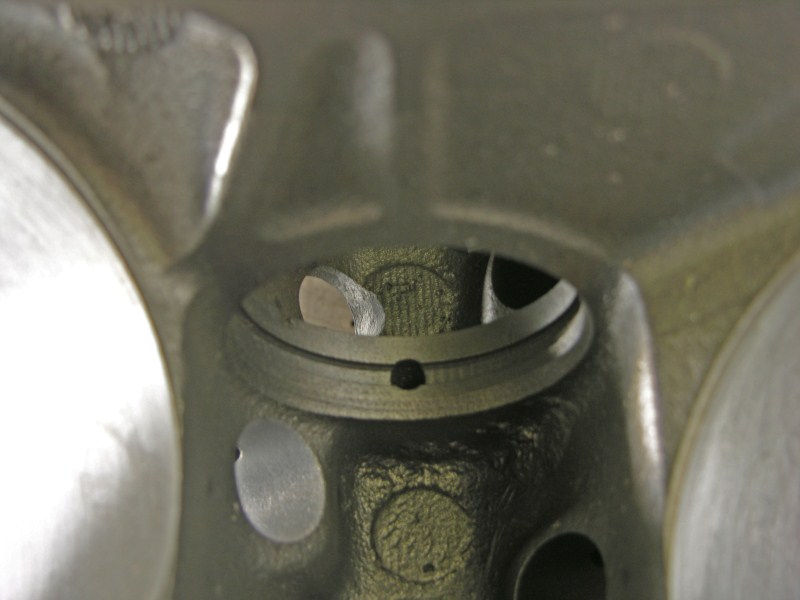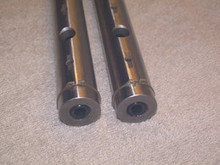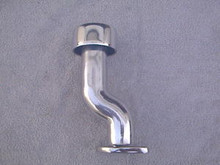I am assembling my 68 390 for my 62 TBird - finally - and had read extensively about FE oiling systems including oil restrictions to rockers. It being a 68 motor, it already has the larger passages 68-up oil filter adapter.
Used the 62 heads with new stainless valves, positive seals and hardened exhaust seats, as the large intake ports in those heads match the Edelbrock F427 aluminum intake that I have had lying around for the last 15 years.
Block is decked, heads resurfaced, 268H cam and matching springs, forged pistons. 9.3:1 CC'd CR with composition gasket. New electronic distributor, ARP pump drive shaft, stock oil pump. FPA ceramic coated headers and rebuilt C6 with shift kit.
I did the block passage enlargement and tapering at oil filter adapter to increase oil flow and have just very slightly tapered the main saddle feed holes to better feed misaligned main bearing feeds on 1,2 and 4, as well as putting restricters in heads that now leave about 7/64th (0.109) inch diameter oil passage remaining open now.
However, when placing the Fel Pro head gaskets in position, I just noticed the oil passage hole in the head gasket is also only about 7/64th in diameter.
So, it seems to me that the head gasket is already restricting the oil flow to top end, since the feed hole coming up is about 5/16th (0.3125), but the head gasket opening over the hole is only 0.109.
The oil has to pass through that small hole in the head gasket before it goes up into head, so doesn't that effectively create the same amount of oil restriction as the restriction I placed in the head passages? Has FE head gasket always had that same size hole at that passage?
I have an additional composition McCord gasket set here that is about 15-20 years old and those gaskets also have the 7/64th oil feed hole in them. So I am wondering why that small hole in the gasket doesn't make my addition of an additional restriction of the rocker feed holes in the heads moot?
Am I missing something? And driver side head gasket is upside-down compared to passenger side? (Printed side up on passenger side, down on driver side). Offends my sense of order but if water passages in back are open and passages in front closed, seems like I have the head gaskets on right...
I understand that type of rockers arms used has implications as to oil flow required to keep them oiled but not an excess amount of oil pooling in valve covers.
Decided to try a new aftermarket set of 1.75 adjustable stainless rockers with bushed arms and roller tips as the cost of refurbishing an old adjustable set cost just as much as just using new ones with the stiffer saddle-type end stands included in the new set.
Not sure if either my 68 or 62 oil return shields will fit with them, but one problem at a time..
But why isn't the small head gasket hole over oil feed a built-in restrictor and how does adding the second restriction make sense unless you want flow restricted even further?
Used the 62 heads with new stainless valves, positive seals and hardened exhaust seats, as the large intake ports in those heads match the Edelbrock F427 aluminum intake that I have had lying around for the last 15 years.
Block is decked, heads resurfaced, 268H cam and matching springs, forged pistons. 9.3:1 CC'd CR with composition gasket. New electronic distributor, ARP pump drive shaft, stock oil pump. FPA ceramic coated headers and rebuilt C6 with shift kit.
I did the block passage enlargement and tapering at oil filter adapter to increase oil flow and have just very slightly tapered the main saddle feed holes to better feed misaligned main bearing feeds on 1,2 and 4, as well as putting restricters in heads that now leave about 7/64th (0.109) inch diameter oil passage remaining open now.
However, when placing the Fel Pro head gaskets in position, I just noticed the oil passage hole in the head gasket is also only about 7/64th in diameter.
So, it seems to me that the head gasket is already restricting the oil flow to top end, since the feed hole coming up is about 5/16th (0.3125), but the head gasket opening over the hole is only 0.109.
The oil has to pass through that small hole in the head gasket before it goes up into head, so doesn't that effectively create the same amount of oil restriction as the restriction I placed in the head passages? Has FE head gasket always had that same size hole at that passage?
I have an additional composition McCord gasket set here that is about 15-20 years old and those gaskets also have the 7/64th oil feed hole in them. So I am wondering why that small hole in the gasket doesn't make my addition of an additional restriction of the rocker feed holes in the heads moot?
Am I missing something? And driver side head gasket is upside-down compared to passenger side? (Printed side up on passenger side, down on driver side). Offends my sense of order but if water passages in back are open and passages in front closed, seems like I have the head gaskets on right...
I understand that type of rockers arms used has implications as to oil flow required to keep them oiled but not an excess amount of oil pooling in valve covers.
Decided to try a new aftermarket set of 1.75 adjustable stainless rockers with bushed arms and roller tips as the cost of refurbishing an old adjustable set cost just as much as just using new ones with the stiffer saddle-type end stands included in the new set.
Not sure if either my 68 or 62 oil return shields will fit with them, but one problem at a time..
But why isn't the small head gasket hole over oil feed a built-in restrictor and how does adding the second restriction make sense unless you want flow restricted even further?







Comment